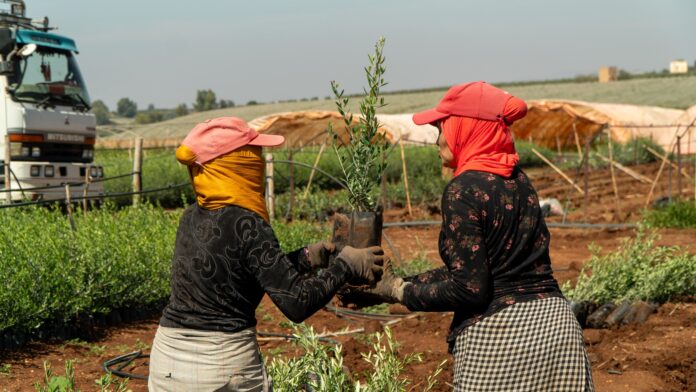Recent assertions have suggested that tree planting is not as effective a climate solution as once thought.
Bill Gates argued in 2023 that the idea of planting enough trees to solve the climate crisis is “complete nonsense,” and the efficacy of tree planting has been a widely debated topic.
While it is clear that only planting trees cannot solve the world’s climate issues, nor will any single action, arguments for moving away from it altogether are often dismissive of the true potential that culturally-appropriate and holistic tree programs can have within larger development initiatives.
The value of the number of trees planted toward mitigating climate impacts must be measured in consideration with the number of women empowered, the number of farming terraces constructed, the number of water pipes installed, the number of family incomes stabilized, and all other measures involved in community development.
Tree Planting Done Wrong
Studies against tree planting as climate action often highlight the impact of underdeveloped tree planting programs, including poor growth rates, destruction of native ecosystems, and monoculture plantations that store minimal carbon.
Such negative effects do exist globally where improperly implemented projects overlook a region’s environmental and social contexts. In fact, tree planting solely for economic gain (often the case with misdirected companies or individuals at the helm), is counterproductive to climate mitigation goals. The true value of tree planting can only be determined when examining them as a whole, from a project’s conception to its wider development impacts.
A Holistic View of Tree Planting
Few people claim that tree planting is a cure-all solution to our environmental crisis, but opposition to tree planting as a major strategy ignores the carefully thought-out projects involving endemic species and local people that have significant, far-reaching impacts.
A truly sustainable initiative must begin with a community’s own indication of their goals, leading to locally developed action plans to achieve those goals. That is to say, a tree planted is not simply a tree but an embodiment of a community’s discovery of these goals and determination to achieve them.
Studies have shown the important value that tree planting projects can have so long as they have clear, locally-determined goals, coordinated efforts between all stakeholders, and a focus on entire ecosystems over single trees.
People plant trees for a number of different reasons including environmental restoration, economic benefit, and cultural or spiritual values. Therefore, the number of trees planted cannot be seen as the end goal but rather a single step in a multi-faceted movement towards development.
It is critical that tree planting be appreciated not only for the trees themselves, but also for their role in the empowerment journeys of communities, the construction of vital agriculture and water infrastructure, the enhancement of food and water security, and the overall fostering of long-term community resilience.
A Model of Planting Trees for Development
When tree planting is launched as a component of larger development, it often results not only in agroforestry-related outcomes, but also other indicators like higher literacy rates, increases in girls’ participation in education, water and school infrastructure, and other vital priorities that communities identify.
In Morocco, a community program has been implemented for agricultural advancement, food security, and women’s empowerment that encompasses tree planting’s transformative potential.
The program applies a new technique to tree planting that shifts from plastic to biodegradable sapling sacks produced by the local women’s cooperative. This project was born from the community’s women themselves who determined that developing their sewing skills would be a rewarding and profitable way to build their cooperative.
Through this initiative, the women benefit from the profits of selling their products and gain a sense of purpose and accomplishment from having built their cooperative. In return, their products offer a more sustainable alternative to typical tree planting methods. These benefits return to the community and cooperative in the form of income for farmers, food products to be consumed or sold, and employment for local people.
Trees in a Cycle of Sustainable Development
Well-designed tree planting programs spark cycles of environmental action and empowerment where each encourages progress in the other. For example, many tree planting techniques improve soil quality, and soils are another major carbon sink. When farmers are empowered to undertake agroforestry practices that improve soil, farm ecosystems as a whole benefit and increase in carbon storage capacity.
Tree planting also creates opportunities for renewable energy. Energy input is critical at all steps of agricultural production, with renewable energy offering the most sustainable approach. For example, integrating solar panels with tree planting to power irrigation means that carbon is sequestered through trees while energy-related carbon emissions are reduced.
This cycle expands beyond the environment through cooperative building, for example, where alternative livelihood sources are built. Sustainable tree planting also enhances food and water security, which has outsized impacts on the health and well-being of a community. When people feel healthier, they are more able to go to school and work and contribute to their communities.
Ultimately, we need this kind of cyclical rather than linear action to see long-term development and avert climate catastrophes. When systems are more resilient, local people become more resilient as well. And, when people begin to see the benefits of tree planting programs, it empowers them to take their efforts even further.
While the act of tree planting alone cannot solve all of the world’s climate problems, the rhetoric that tree planting is ‘nonsense’ discourages investment into reforestation and afforestation initiatives that are increasingly critical and have proven to be successful in sparking long-term development processes.

